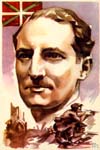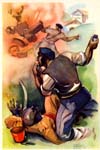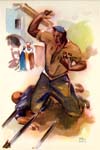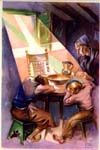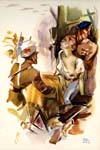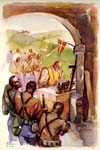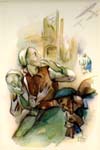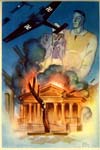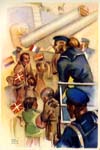The Basque War
Estampas de la Guerra en Euskadi
Ediciones españolas
Series of 10
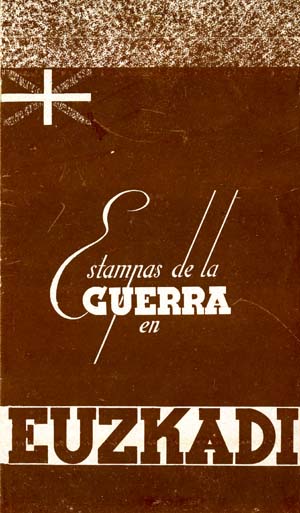
Following the outbreak of war in July of 1936, the Republican government secured passage of a statute of autonomy for the Basque Country. Previously blocked in the Cortes, the statute secured the commitment of the Partido Nacionalista Vasco (PNV) to the Republican fold. Dating to its creation in 1896, the avowedly confessional nature of the PNV riled more radical members of the Republican coalition who feared Basque sympathies were closer to the Nationalist cause. The Basque nationalists for their part feared the centralizing preferences of the right and favored the protection of traditional privileges. A strong separatist vein in the origins of nationalist movement also made the possibility of complete independence for the region after the war a worthy goal for many willing to take up arms.
The Basque statute took effect on 1 October 1937. Seven days later, the leader of the PNV, José Antonio de Aguirre assumed the title of lehendakari, making him the legal head of the putative state of Euskadi. Working with other parties, Aguirre formed a government charged with administrative authority and management of the war effort in the region. His cabinet members quickly began work on the formation of a Basque army (Eusko Gudarostea), alternate lines of communication with friendly foreign governments, and even non-military endeavors like the creation a Basque university. Refusing incorporation into a unified Republican military structure, Aguirre took direct command of the Basque army for a period. After a brief nine months in existence, the capitulation of Bilbao in June of 1937 led to the fall of Euskadi. Basque refugees fled to neighboring Cantabria and many eventually to locations overseas.
The set of ten postcards included below chronicle life and events surrounding the war in Euskadi. They remain bound by a weak line of detachable perforation to a spine with a protective covering, probably in the condition from which they were first sold or distributed. As individual works of propaganda, it is likely these postcards were meant for delivery to persons outside of Spain. The highly evocative images would have served the interests of encouraging those living abroad to make foreign governments take a stand on the war. Republican strategy in the war was severely limited by the decision of many western powers, notably Great Britain and France, top pursue a course of non-intervention. Though destinations in Europe may have been an intended audience, the large numbers of ethnic Basques living in Latin America would have been another likely possibility.
The exact date of publication for the set remains unknown. Given references to the bombing of Guernica, which took place in late April of 1937, the set may date to May of 1937 at the earliest. It seems unlikely that the publisher would have had much cause for printing the set after the fall of Bilbao in mid-June. The publisher, Ediciones españolas, is acknowledged to have operated offices in Madrid, Valencia, and Barcelona. Though these cities served as seats of the Republican government during the war, the subject matter and content of the set suggests a Basque commission. The images in this set were completed by Paco Ribera.
NOTE: The captions below were taken form the postcards themselves. At the top of each section, the Spanish text appears in bold. Successive lines list alternate French and English translations taken from the reverse side. All captions were taken from the reverse side.

